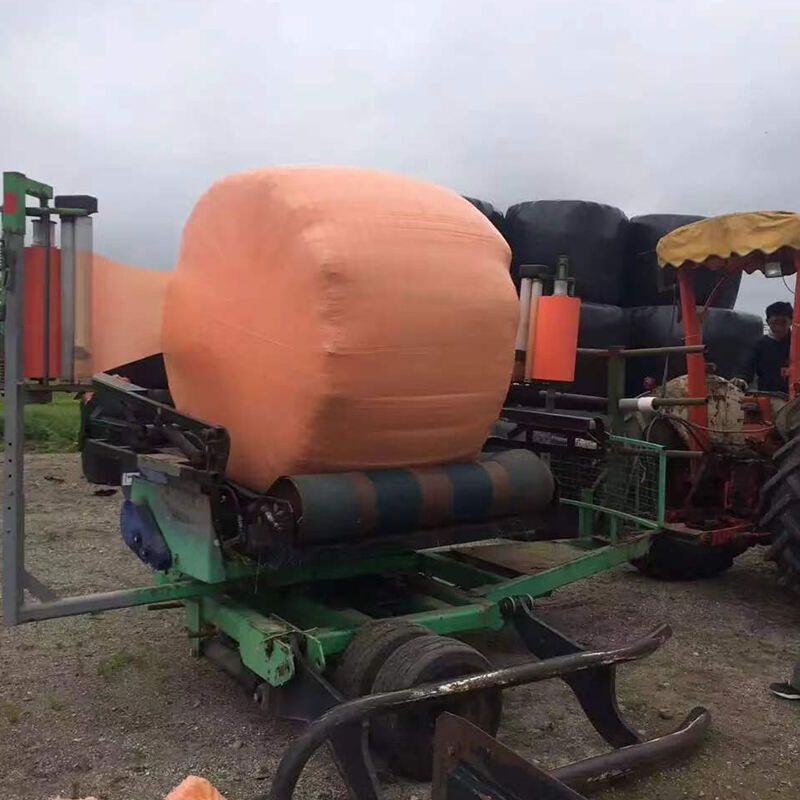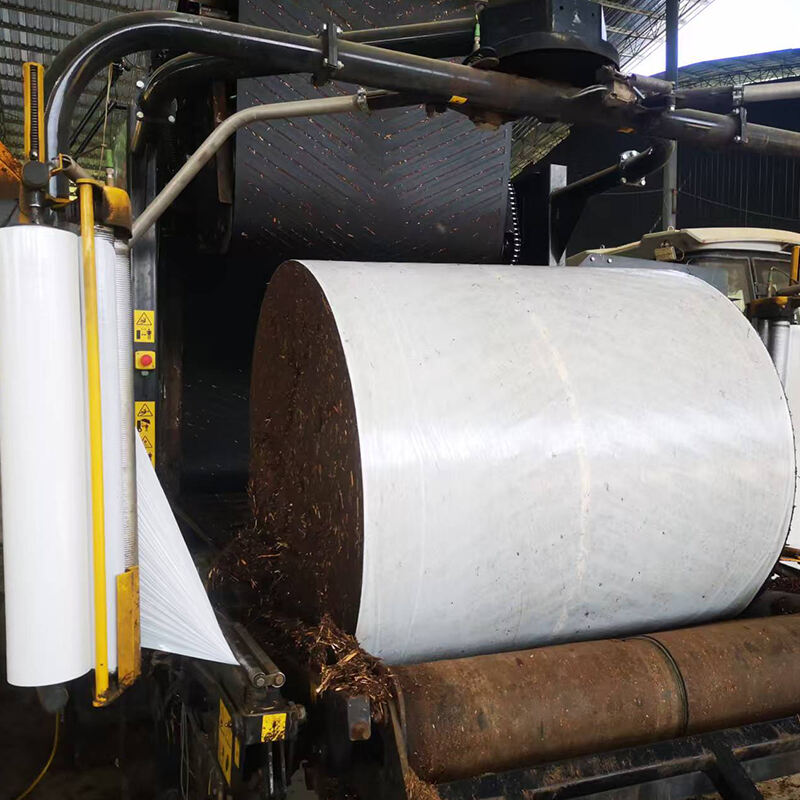စိလေ့ချုပ်ငြမ်း ဖလင်အကြောင်းနှင့် အခြေခံများကို နားလည်ခြင်း
ဖွဲ့စည်းတည်ဆောက်ပုံနှင့် အောက်ဆီဂျင်တားဆီးသည့် နည်းပညာ
စိုက်ပျိုးရေးတွင် အသုံးပြုသော ပိုလီအက်သလင်းပလပ်စတစ်များဖြင့် အဓိကထုတ်လုပ်ထားသော အမွှေးသီးစားသုံးနိုင်သည့် ဖလင်များသည် အမွှေးသီးကို ထိန်းသိမ်းရာတွင် အရေးပါသော အခန်းကဏ္ဍမှ ပါဝင်ပါသည်။ အမွှေးသီးကို အောက်ဆီဂျင်မပါသော အခြေအနေများဖြင့် ထိန်းသိမ်းရန် လိုအပ်သောကြောင့် ဖလင်များသည် အောက်ဆီဂျင်ကို ဖြတ်သန်း၍ မရအောင် တားဆီးပေးနိုင်ခြင်းသည် အထူးအရေးပါပါသည်။ ထုတ်လုပ်သူများက အထူးပြုလုပ်ထားသော ဖလင်များတွင် အောက်ဆီဂျင်ကို ထိထိရောက်ရောက် တားဆီးနိုင်ရန်အတွက် ဓာတုပစ္စည်းများကို ထည့်သွင်းထားပါသည်။ ထို့ကြောင့် အမွှေးသီးထုပ်များအတွင်းသို့ လေဝင်ခြင်းကို ပိုမိုကောင်းမွန်စွာ တားဆီးပေးနိုင်ပါသည်။ ထိုအဆင့်မြှင့်တင်ထားသော ဖလင်များကို အသုံးပြုလာသော စိုက်ပျိုးရေးလုပ်ငန်းရှင်များက အမွှေးသီး၏ အရည်အသွေးကို သိသာထင်ရှားစွာ တိုးတက်လာခြင်းကို အစီရင်ခံပါသည်။ အောက်ဆီဂျင်ကို တားဆီးနိုင်သော အရည်အသွေးကောင်းများသော ဖလင်များကို အသုံးပြုခြင်းဖြင့် အမွှေးသီးများ ပျက်စီးမှုကို ၂၀ ရာခိုင်နှုန်းခန့် လျော့နည်းစေနိုင်ပြီး နွားများအတွက် အစားအသောက်အရည်အသွေးကို ပိုမိုကောင်းမွန်လာစေပါသည်။
အလွှာများစွာပါဝင်သော တည်ဆောက်ပုံကို ရှင်းပြခြင်း
စားနိုင်သော အကာအကွယ်ဖြစ်သည့် အလွှာတစ်ခုတည်းပါသော ရိုးရှင်းသော ပစ္စည်းများမှ စီလေ့ခ်ဖလင်နည်းပညာများသည် အများအားဖြင့် အဆင့်များစွာတိုးတက်လာပါသည်။ ခေတ်မှီပစ္စည်းများတွင် ပေါလီအက်သလင်းများကို အလွှာများစွာထပ်ပိုး၍ အသုံးပြုထားပြီး အလွှာတစ်ခုချင်းစီသည် သိုလှောင်မှုအတွက် လိုအပ်သည့်အရာများအပေါ် အခြေခံ၍ တာဝန်များကွဲပြားပါသည်။ အပြင်ဘက်အလွှာများသည် နေရောင်ခြည်ထဲတွင် ဖလင်ပျက်စီးမှုမဖြစ်စေရန် ယူဗီကာကွယ်ပေးပါသည်။ အလယ်အလွှာများသည် ဖလင်ကိုင်တွယ်ရာတွင် ဖြစ်ပေါ်နိုင်သော ပြတ်တောက်မှုများနှင့် ထိုးဖောက်ခံရမှုများကိုခံနိုင်ရည်ရှိစေရန် အားကောင်းမာကျောစေပါသည်။ နောက်ဆုံးအတွင်းဆုံးအလွှာသည် အောက်စီဂျင် ထဲသို့ဝင်ရောက်မှုကိုတားဆီးပေးသော တင်းကျပ်သော အကာအကွယ်အဖြစ် ဆောင်ရွက်ပါသည်။ အခြေခံပလပ်စတစ်အုပ်ထားသော ပစ္စည်းများကိုအသုံးပြုခဲ့သည့်အချိန်ကထက် စီလေ့ခ်များကို အသုံးပြုသော မွေးမြူရေးသမားများသည် စီလေ့ခ်များကို အသုံးပြုနိုင်သည့်အချိန်ကို ၃၀ ရာခိုင်နှုန်းခန့် ကြာရှည်စေပါသည်။ ဤတိုးတက်မှုသည် အထူးတန်ဖိုးရှိသည့်အကြောင်းရင်းမှာ အစာရေစာများတွင် အရေးကြီးသော အာဟာရဓာတ်များကို သိုလှောင်ထားသည့်အချိန်ကြာလောက်စွာကြာမြင့်စေခြင်းမရှိဘဲ ထိန်းသိမ်းပေးနိုင်သောကြောင့်ဖြစ်ပါသည်။
အာဟာရထိန်းသိမ်းမှုအတွက် စီလေ့ဖလင်၏ အဓိကအကျိုးကျေးဇူးများ
အာဟာရဓာတ်များ ထိန်းသိမ်းခြင်းနှင့် ဖောက်ပြန်မှုကိုထိန်းချုပ်ခြင်း
အောက်ဇီကို ကာကွယ်ပေးသော အထပ်လိုက်ပလပ်စတစ်ဖြင့် ပြုလုပ်ထားသော အစာကို တိရစ္ဆာန်များအား အာဟာရပြည့်ဝစွာ ကျွေးမွေးနိုင်ရန်အတွက် စီလိက်ဖလင်များသည် အရေးပါပါသည်။ ထိုဖလင်များက လေကိုမဝင်ရောက်စေသော အတားအဆီးတစ်ခု ဖန်တီးပေးသည့်အခါတွင် သဘာဝအတိုင်း အက်စစ်ဓာတ်ဖျက်စီးမှုကို ဖြစ်ပေါ်စေပါသည်။ စီလိုက်ကို ကောင်းစွာမွှေပေးခြင်းမပြုလုပ်ထားသော အစာနှင့် နှိုင်းယှဉ်ပါက တိရစ္ဆာန်များ၏ အစာခြေစနစ် တိုးတက်မှုကို ၁၀ ရာခိုင်နှုန်းခန့် တိုးတက်မှုကို တွေ့ရပါသည်။ ဤနေရာတွင် ဖြစ်ပေါ်နေသော လုပ်ငန်းစဉ်မှာ ရိုးရှင်းပါသည်။ ထိန်းချုပ်ထားသော ပတ်ဝန်းကျင်မှာ လေဝင်ရောက်မှုကြောင့် ဖြစ်ပေါ်သော အာဟာရဆုံးရှုံးမှုကို တားဆီးပေးသည်။ အချိန်ကြာလာသည်နှင့်အမျှ တိရစ္ဆာန်များသည် အစာမှ ပိုမိုသော အာဟာရကို ရရှိပြီး အစာသည် မပျက်စီးဘဲ တည်ငြိမ်နေပါသည်။ ကျန်းမာသော တိရစ္ဆာန်များမှာ စိုက်ပျိုးရေးလုပ်ငန်းများတွင် ထုတ်လုပ်မှုစွမ်းရည်ကို တိုးတက်စေပါသည်။
မှိုများကိုကာကွယ်ခြင်းနှင့် အကျအနကိုလျော့နည်းစေခြင်း
စပါးရိတ်သိမ်းပြီးနောက် အောက်စီဂျင်ကင်းသော ပတ်ဝန်းကျင်ကို ဖန်တီးပေးသည့် စီလိ့ဖလင်များသည် အစွန်းထွက်များ ဖြစ်ပေါ်မှုကို လျော့နည်းစေပြီး အစာအိတ်များကို ၁၅ မှ ၂၀ ရာခိုင်နှုန်းခန့် ကယ်တင်ပေးနိုင်သည်။ ထို့ပြင် ဖလင်များသည် မြေပြင်မှ ရေစိမ့်ထွက်မှုကိုလည်း လျော့နည်းစေပြီး စိမ့်ယိုမှုကို စိုက်ပျိုးရေးလုပ်ငန်းများတွင် သန့်ရှင်းမှုကို ထိန်းသိမ်းပေးနိုင်သည်။ အရည်အသွေးကောင်းသော ဖလင်များကို ရင်းနှီးမြှုပ်နှံခြင်းဖြင့် အစာကို သိမ်းဆည်းထားနိုင်မှုအပြင် အခြားနည်းလမ်းများစွာဖြင့် အကျိုးကျေးဇူးများစွာ ရရှိနိုင်သည်။

မွေးမြူရေးတိရစ္ဆာန်များ၏ကျန်းမာရေးနှင့်ထုတ်လုပ်မှုအပေါ်သက်ရောက်မှု
အရည်အသွေးကောင်းသော စားကျွေးရေးဇာအထည်များက တိရစ္ဆာန်မွေးမြူရေးကျန်းမာရေးအတွက် အမှန်တကယ်ကွာခြားမှုကို ဖန်တီးပေးပါသည်။ ထိုသို့ဖန်တီးပေးခြင်းကြောင့် တိရစ္ဆာန်များသည် အရည်အသွေးပိုကောင်းသော အပင်များကို စားသုံးနိုင်မည်ဖြစ်ပါသည်။ တိရစ္ဆာန်များသည် အရည်အသွေးကောင်းသော အစားအစာများကို စားသုံးပေးပါက တိရစ္ဆာန်များ၏ ကျန်းမာရေးအခြေအနေမှာ ပိုမိုကောင်းမွန်လာပြီး ပိုမိုမြန်ဆန်စွာ ကြီးထွားလာမည်ဖြစ်ပါသည်။ ထို့ကြောင့် တိရစ္ဆာန်မွေးမြူရေးခြံများမှ နို့နှင့် အသားထွက်ပိုမိုရရှိလာမည်ဖြစ်ပါသည်။ နောက်ဆုံးတွင် စီးပွားရေးအတွက် အမြတ်အစွန်းများကို တိုးတက်စေပါသည်။ ကျန်းမာသောတိရစ္ဆာန်များကို ထားရှိခြင်းကြောင့် ဆေးကုသမှုများအတွက် ကုန်ကျစရိတ်ကို လျော့နည်းစေပါသည်။ အဘယ်ကြောင့်နည်းဟူမူ တိရစ္ဆာန်များအား ဆေးဝါးများ သို့မဟုတ် ကုထုံးများ ပေးရန် လိုအပ်သည့်အခြေအနေများ နည်းပါးလာမည်ဖြစ်ပါသည်။ တိရစ္ဆာန်ကျန်းမာရေးအတွက် ကုန်ကျစရိတ်များကို ခြောက်ခြားစွာ သက်သာစေပါသည်။ ထို့ကြောင့် မွေးမြူရေးရှင်များသည် တိရစ္ဆာန်များကို ကျန်းမာစွာထားရှိနိုင်ပြီး တိတိကျကျ မဟုတ်သော ဆေးကုသမှုကုန်ကျစရိတ်များကို များပြားစွာ ကျော်လွှားနိုင်ပါသည်။
UV ခုခံနိုင်မှုနှင့် ခံနိုင်ရည်ရှိမှု အချက်များ
ပြင်ပတွင် အလုပ်လုပ်သည့်အခါ ရင်ဆိုင်ရသည့် စိန်ခေါ်မှုများ
နေရောင်ခြည် UV တွေက နေ့တိုင်းခံနေရတဲ့ အချိုးစားဖလင်တွေမှာ UV ခုခံနိုင်မှုက အရေးကြီးပါတယ်။ အရည်အသွေးကောင်းတွေကတော့ နေရောင်ဒဏ်ကိုခံနိုင်အောင် တည်ဆောက်ထားတာဖြစ်လို့ ၁၈ လအထိတောင် စမ်းသပ်မှုတွေမှာ တွေ့ရပါတယ်။ ဒါပေမယ့် အမှန်ပြောရရင်တော့ ဖလင်တိုင်းကတော့ အတူတူမဟုတ်ပါဘူး။ ဈေးပိုသက်သာတဲ့ ဖလင်တွေက အချိန်ကြာလာတဲ့အခါ ပျက်စီးလာတတ်ပြီး ကျိုးတော့တဲ့အထိဖြစ်တတ်လို့ အစာကိုပျက်စီးစေပြီး အကုန်အကျပိုများလာစေပါတယ်။ မိုးလေဝသဒဏ်ကိုခံနိုင်တဲ့ ပစ္စည်းတွေကိုရွေးချယ်ဖို့တော့ လယ်သမားတွေအနေနဲ့ လိုအပ်ပါတယ်။ ဒါမှသာ အချိုးစားတွေကိုစုဆောင်းထားတဲ့ အလုပ်ကို အကျိုးရှိရှိလုပ်ဆောင်နိုင်မှာဖြစ်ပါတယ်။
အသက်ရှည်ရေးအတွက် ပစ္စည်းဗေဒ
ပစ္စည်း သိပ္ပံ နည်းပညာ တိုးတက်မှုများ ကြောင့် ဆီလေ့ခ် ဖလင်များ အချိန်ကြာလာသည်နှင့်အမျှ တောင့်တင်းသော အပြင်ပန်း အခြေအနေများကို ခံနိုင်ရည်ရှိမှု ပြောင်းလဲသွားပါသည်။ ဖလင်၏ ဆွဲခြင်းခံရသောအခါ အားကောင်းမှု (tensile strength) နှင့် ကျဲလွန်းသောအခါ ကျဲနိုင်သည့် ပမာဏ (elongation) ကဲ့သို့သော အချက်များကို ထုတ်လုပ်သူများ ဂရုစိုက်သောအခါ အသုံးပြုရန် ကြာရှည်ခံသော ဖလင်များ ထုတ်လုပ်နိုင်ပါသည်။ ယူဗီဓာတ် တားဆီးသော ဓာတုပစ္စည်းများ ထည့်ခြင်းသည် ပလပ်စတစ်ပြားများကို နေရောင်မှ ကာကွယ်ပေးသောကြောင့် ဖလင်သည် ပုံမှန် ပေါလီအီသီလင် ထုတ်ကုန်များထက် နှစ်ဆခန့် ကြာရှည်ခံနိုင်သည်ဟု သုတေသနများမှ ပြသထားပါသည်။ ထို့ကြောင့် ထိုကဲ့သို့သော နည်းပညာတိုးတက်မှုများ ပါဝင်သော ဖလင်များကို ရွေးချယ်သော မွေးမြူရေးသမားများသည် သိုလှောင်စဉ် သီးနှံများကို ပိုမိုကောင်းမွန်စွာ ကာကွယ်ပေးနိုင်ပြီး ပျက်စီးသော ဖုံးအုပ်များကို မကြာခဏ အစားထိုးရန် မလိုအပ်တော့သောကြောင့် ငွေကုန်ကျစရိတ် သက်သာစေပါသည်။
လျှောက်လွှာအကောင်းဆုံးအလေ့အကျင့်များ
လေကို မဝင်မရှိနိုင်သော ပိတ်ဆို့မှုနည်းလမ်းများ ရရှိခြင်း
ထုတ်လုပ်မှုအရည်အသွေးကို ထိန်းသိမ်းရန်အတွက် အောက်စီဂျင်ပိတ်ဆို့မှုသည် အလွန်အရေးကြီးပါသည်။ အက်စီဂျင်ပိတ်ဆို့မှုကောင်းစွာလုပ်ဆောင်ပေးပါက အောက်စီဂျင်ပါဝင်မှုကို လျော့နည်းစေပြီး သိုလှောင်ထားသောအစားအစာ၏ အရည်အသွေးနှင့် အာဟာရဓာတ်များကို ထိန်းသိမ်းထားနိုင်ပါသည်။ စိုက်ပျိုးရေးလယ်ကွင်းများတွင် စမ်းသပ်မှုများအရ အောက်စီဂျင်ပိတ်ဆို့မှုကောင်းစွာလုပ်ဆောင်ပေးပါက အောက်စီဂျင်ပါဝင်မှုကို ၉၅ ရာခိုင်နှုန်းခန့် လျော့နည်းစေပြီး အစားအစာများ မြန်မြန်မပျက်စီးစေရန် အကူအညီပေးပါသည်။ အကောင်းဆုံးရလဒ်များရရှိရန်အတွက် အထူးပိတ်ဆို့ရေးကိရိယာများကို ရင်းနှီးမြှုပ်နှံခြင်းသည် ဖလင့်ပိတ်ဆို့မှုကောင်းစွာဖြစ်စေရန်အတွက် အထောက်အကူဖြစ်စေပါသည်။ ထို့အပြင် အဖွဲ့ဝင်များကို ဤနည်းလမ်းများကို မှန်ကန်စွာအသုံးပြုနိုင်ရန် သင်ကြားပေးခြင်းကိုလည်း မမေ့လျော့တတ်ပါနှင့်။ သင့်တော်သော သင်ကြားပေးမှုမရှိပါက အကောင်းဆုံးကိရိယာများပင်လျှင် အကျိုးသက်ရောက်မှုနည်းပါးမည်ဖြစ်ပြီး အားနည်းသောပိတ်ဆို့မှုများကြောင့် တိရစ္ဆာန်များသည် အစားအစာကို မှန်ကန်စွာသိုလှောင်မထားနိုင်သောကြောင့် နောက်ပိုင်းတွင် ရောဂါဝေဒနာများခံစားရနိုင်ပါသည်။
Bale Wrapping vs. Bunker Covering
ဘောင်လုံးပတ်ထားခြင်းနှင့် ဘန်ကာကိုက်ဖြင့် ဖုံးအုပ်ခြင်းတို့ကို အသုံးပြုရမည့်အချိန်ကို သိရှိခြင်းသည် သိမ်းဆည်းထားသော ပြားစာမှ ကောင်းမွန်သော ရလဒ်များရရှိရန်အတွက် အကျိုးသက်ရောက်မှုရှိပါသည်။ သေးငယ်သော စိုက်ခင်းများအတွက် တစ်ခုချင်းစီကို ပတ်ထားခြင်းသည် အလုပ်ဖြစ်ပါသည်။ အဘယ်ကြောင့်ဆိုသော် မည်သည့်အချိန်တွင်မဆို လိုအပ်သော ပြားစာကိုသာ သိမ်းဆည်းနိုင်စေရန် ကူညီပေးပါသည်။ ထိုနည်းလမ်းသည် ပြားစာလိုအပ်ချက်များသည် ရာသီအလိုက်ပြောင်းလဲနေသော စိုက်ခင်းများ သို့မဟုတ် ကြီးမားသော သိမ်းဆည်းရန်နေရာများအတွက် နေရာမလုံလောက်သော စိုက်ခင်းများတွင် အထောက်အကူဖြစ်စေပါသည်။ သို့ရာတွင် ပိုကြီးမားသော လုပ်ငန်းများကိုကြည့်လျှင် ဘန်ကာကိုက်ဖြင့်ဖုံးအုပ်ခြင်းသည် ပိုကောင်းမွန်ပါသည်။ အဘယ်ကြောင့်ဆိုသော် ပိုမိုများပြားသော ပြားစာကို သိမ်းဆည်းနိုင်စေရန် ကူညီပေးပြီး ဆုံးရှုံးမှုများကိုလည်း လျော့နည်းစေပါသည်။ လေ့လာမှုများအရ ဖုံးအုပ်ထားသော ဘန်ကာများသည် အခြားနည်းလမ်းများနှင့် နှိုင်းယှဉ်ပါက ပြားစာပမာဏများကို လွယ်ကူစွာ ရယူနိုင်ခြင်းနှင့် ပျက်စီးမှုကို သက်သာစေခြင်းတို့ကို ပြသပါသည်။ လုပ်ငန်းအရွယ်အစားအပေါ် မူတည်၍ မှန်ကန်သော စနစ်ကိုရွေးချယ်ခြင်းသည် ပြားစာကို ကောင်းမွန်စွာသိမ်းဆည်းနိုင်မှုကို တိုးတက်စေရုံသာမက တစ်နှစ်ပတ်လုံးအတွင်း ရာသီဥတုအမျိုးမျိုးကို ကြုံတွေ့ရမည့်အခါတွင် ယုံကြည်စိတ်ချရသော ပြားစာပေးနိုင်မှုကိုလည်း သေချာစေပါသည်။
ပတ်ဝန်းကျင်နှင့် တည်တံ့ခိုင်မြဲရေးအရာများ
ပြန်လည်အသုံးပြုနိုင်သောပစ္စည်းများ၏ တီထွင်မှုများ
ကုန်ကြမ်းများကို ပြန်လည်အသုံးပြုနိုင်သည့် စီလိက်ဖလင့်များအား လယ်သမားများက ပြန်လည်အသုံးပြုနိုင်မှုအား အထောက်အကူပြုသည့် တိုးတက်မှုများကို မကြာသေးမီက တွေ့ရပါသည်။ အမှိုက်များကို တစ်နှစ်တာအတွင်း အများအပြားထုတ်လုပ်သည့် အမျိုးအစားများကို လျော့နည်းစေရန် အရေးကြီးပါသည်။ ယခုအခါတွင် ကုမ္ပဏီအချို့က အထူးပါဝင်ပစ္စည်းများဖြင့် ဖလင့်များကို ထုတ်လုပ်လျက်ရှိပြီး အလင်းရောင်နှင့် စိုစွတ်မှုတို့ကို ထိတွေ့မှုကြောင့် သဘာဝအားဖြင့် ပျက်စီးနိုင်သည်။ လယ်သမားများက အမှိုက်များစွန့်ထုတ်ရာတွင် ငွေကုန်ကျစရိတ်ကို ခြွေတာနိုင်ပြီး လယ်ကွင်းများကို သန့်ရှင်းစေသည်ဟု အစီရင်ခံပါသည်။ စိတ်ဝင်စားဖွယ်ကောင်းသည့် အချက်မှာ ကမ္ဘာတစ်ဝှမ်းရှိ စိုက်ပျိုးရေးလုပ်ငန်းများအတွက် ကျယ်ပြန့်သော တာဝန်ယူမှုရှိသည့် ရည်မှန်းချက်များအတွင်းသို့ ဤအရာများဝင်ရောက်လာခြင်းဖြစ်ပြီး ပလပ်စတစ်ကို အသုံးပြုမှုကို လျော့နည်းစေရန် ရှာဖွေနေသည့်အပြင် မျိုးစေ့ထွက်နှုန်းကို မလျော့နည်းစေဘဲ အသုံးပြုနိုင်သည့်နည်းလမ်းများကို ပိုမိုရှာဖွေလာနေခြင်းဖြစ်ပါသည်။
တိရစ္ဆာန်မွေးမြူရေး လုပ်ငန်းများတွင် အမှိုက်လျော့နည်းမှု
သင့်လျော်စွာ အသုံးပြုပါက စားကျွေးရေးအထုပ်ပိုးရေးပလပ်စတစ်ဖလင့်များသည် မွေးမြူရေးစိုက်ပျိုးသူများတွင် အကုန်အကျကို လျော့နည်းစေပြီး စိုက်ပျိုးမွေးမြူရေးလုပ်ငန်းများကို ပိုမိုခိုင်မာစေပါသည်။ ပလပ်စတစ်အထုပ်များသည် အစာကို သိမ်းဆည်းရာတွင် အရေးကြီးသောအရာဖြစ်ပြီး သိမ်းဆည်းထားသောအစာများ မှန်ကန်စွာ ပျက်စီးမှုကို လျော့နည်းစေခြင်းဖြင့် မီသိန်းဂက်စ်ထုတ်လုပ်မှုကို လျော့နည်းစေပါသည်။ မီသိန်းဂက်စ်မှာ သိမ်းဆည်းထားသောအစာများ မှန်ကန်စွာ ပျက်စီးမှုမဖြစ်ပေါ်စေသောအခါ ထုတ်လုပ်သော ဂရင်ဟောက်စ်ဂက်စ်များထဲမှ တစ်ခုဖြစ်ပါသည်။ ဤသို့သော သိမ်းဆည်းမှုပုံစံကို ပြောင်းလဲအသုံးပြုသော စိုက်ပျိုးသူများသည် ငွေကြေးဆိုင်ရာအကျိုးကျေးဇူးများကို ရရှိသည့်အပြင် ရာသီဥတုပြောင်းလဲမှုကိစ္စများကို ကူညီပေးနိုင်ပါသည်။ ငွေကြေးဆိုင်ရာအကျိုးကျေးဇူးများသည် ပတ်ဝန်းကျင်ဆိုင်ရာအောင်မြင်မှုများနှင့်အတူ ဖြစ်ပေါ်လာပြီး များစွာသောစိုက်ပျိုးသူများက ဝင်ငွေတိုးတက်မှုဟု သုံးသပ်ကြပါသည်။ မည်သည့်အဖြေကမျှ ပြည့်စုံခြင်းမရှိသော်လည်း အများအားဖြင့် ကျွမ်းကျင်သူများက စားကျွေးရေးစီမံခန့်ခွဲမှုကို တက်ကြီးစွာ လုပ်ဆောင်ခြင်းသည် ထုတ်လုပ်မှုကို မစွန့်လွှတ်ဘဲ ပတ်ဝန်းကျင်နှင့် ညီညွတ်သော စိုက်ပျိုးမွေးမြူရေးလုပ်ငန်းများသို့ တကယ့်တမ်းတိုးတက်မှုကို ကိုယ်စားပြုပါသည်။
အစာအရည်အသွေး ရလဒ်များကို အကောင်းဆုံးဖြစ်စေခြင်း
အချဉ်ဖောက်ခြင်းမှ တိရစ္ဆာန်အာဟာရအထိ
သိုလှောင်ထားသော အစဦးတွင် အစာအဖြစ် တိရစ္ဆာန်များကို ပေးသောအခါတွင် အာဟာရကောင်းမွန်စေရန် အချို့နှင့်အညီ အရည်အသွေးကို မြှင့်တင်ပေးခြင်းသည် အရေးကြီးပါသည်။ သိုလှောင်ထားသော အစဦးကို ဂရုတစိုက်စောင့်ကြည့်ပြီး အရည်အသွေးမြင့် ဖလင့်များတွင် ရင်းနှီးမြှုပ်နှံသော မွေးမြူရေးသမားများသည် သဘာဝအချို့ဖြစ်စဉ်ကို အကျိုးရှိစေရန် အခြေအနေများကို ဖန်တီးပေးပါသည်။ Silostop Max ကဲ့သို့သော ထုတ်ကုန်များသည် လေဝင်ခြင်းကိုတားဆီးပေးသောကြောင့် အာဟာရဓာတ်ကို ပိုမိုထိန်းသိမ်းထားနိုင်ပြီး တိရစ္ဆာန်များအား ကျန်းမာစေပါသည်။ အချို့ကို သင့်တော်စွာ ပိတ်ဆို့ထားပါက စနစ်တစ်ခုလုံးသည် ပိုမိုကောင်းမွန်စွာ အလုပ်လုပ်ပြီး အစာကျွေးချိန်တွင် ပိုမိုကောင်းမွန်သော ရလဒ်များကို ပေးဆောင်ပြီး တိရစ္ဆာန်များကို အကောင်းဆုံးအခြေအနေတွင် ထိန်းသိမ်းထားပေးပါသည်။
စိုက်ပျိုးရေးလုပ်ငန်းများတွင် စီးပွားရေးဆိုင်ရာသက်ရောက်မှု
အဆင့်မြှင့် အာဟာရဓာတ်ပေါင်းစပ်ထားသော ပိုမိုကောင်းမွန်သော အထည့်အလိပ်များသည် စီးပွားရေးအကျိုးအမြတ်ကို တိုးတက်စေရန် ရှာနေသော စိုက်ပျိုးရေးလုပ်ငန်းများအတွက် အကျိုးအမြတ်များစွာ ဖြစ်စေပါသည်။ ကောင်းမွန်သော အထည့်များကို ရင်းနှီးမြှုပ်နှံသည့်အခါ သိမ်းဆည်းထားသော အာဟာရဓာတ်များ ပျက်စီးမှုနည်းပါးပြီး တိရစ္ဆာန်များသည် အသုံးပြုနိုင်သော အရာများကို ပိုမိုစားသုံးလာကြပါသည်။ အချို့လုပ်ငန်းများတွင် ပစ္စည်းများကို အဆင့်မြှင့်ပြီးနောက် ထိရောက်မှုသည် ၂၅% ခန့် တိုးတက်မှုကို တွေ့ရပါသည်။ ချွေတာရရှိသော ငွေများမှာ အနည်းငယ်မျှသာမကဘဲ တစ်လတစ်လ တိုးတက်မှုများကို တွေ့ရပြီး အချိန်ကြာလာသည်နှင့်အမျှ လုပ်ငန်းစုစုပေါင်းကို ငွေရေးကြေးရေးအရ ပိုမိုကောင်းမွန်လာစေပါသည်။ အာဟာရဓာတ်ကို သိမ်းဆည်းရာတွင် အထည့်များအား အဆင့်မြှင့်သော စိုက်ပျိုးရေးလုပ်ငန်းများသည် အာဟာရဓာတ်များ ပျက်စီးခြင်း သို့မဟုတ် ညစ်ညမ်းမှုများကို လျော့နည်းစေပြီး စီးပွားရေးလုပ်ငန်းကို ပိုမိုကြာရှည်စွာ ဆက်လက်လုပ်ဆောင်နိုင်ပါသည်။ အစဦးတွင် ကုန်ကျစရိတ်သည် အသုံးအနှုန်းလျော့နည်းလာခြင်းနှင့်အမျှ တိရစ္ဆာန်များ၏ စွမ်းဆောင်ရည်မှာ အာဟာရဓာတ်ကို စားသုံးနိုင်မှုကြောင့် တိုးတက်လာပါသည်။
မေးလေ့ရှိသောမေးခွန်းများ
Silage ဖလင်များကို ဘာဖြင့်ပြုလုပ်ထားပါသနည်း။
Silage ဖလင်များကို အဓိကအားဖြင့် polyethylene ဖြင့် ပြုလုပ်ထားပြီး အောက်ဆီဂျင်အတားအဆီး ဂုဏ်သတ္တိများကို တိုးတက်စေရန်အတွက် အထူးပြုထည့်သွင်းထားသော ဓာတုပစ္စည်းများကို ထည့်သွင်းပြုလုပ်ထားပါသည်။
ဆိုင်လေ့ခ်ဖလင့်များသည် ပျက်စီးမှုကို မည်ကဲ့သို့ကာကွယ်ပေးပါသလဲ
Silage ဖလင်များသည် အောက်ဆီဂျင်အတားအဆီးကို ဖန်တီးခြင်းဖြင့် ပုံမှန်အခြေအနေများကို ထိန်းသိမ်းထားပြီး အသုံးမဝင်သော ပျက်စီးမှုကို ၂၀% အထိ လျော့နည်းစေပါသည်။
အများလွှာ Silage ဖလင်များ၏ အားသာချက်မှာ အဘယ်နည်း။
များလေ့ယာစပ်ဖလင့်များသည် ဆီလေ့ချိန်ကြာရှည်စေရန်အားပေးပြီး အောက်စီဂျင်ပိတ်ဆို့မှု၊ ဓာတ်မြောက်ခံနိုင်မှုနှင့် UV ကာကွယ်မှုတို့ကိုတိုးတက်စေပါသည်။
တိရစ္ဆာန်အစာကျွေးမွေးမှုအပေါ် ဆီလေ့ဖလင့်များ၏သက်ရောက်မှုမှာအဘယ်နည်း။
Silage ရုပ်ရှင်များသည် အာဟာရကြွယ်ဝသောအစာများကို ထိန်းသိမ်းခြင်း၊ အစာခြေခြင်းကို ကောင်းမွန်အောင်ပြုလုပ်ခြင်းနှင့် တိရစ္ဆာန်ဆေးကုခန်းစရိတ်များကို လျှော့ချခြင်းဖြင့် တိရစ္ဆာန်များ၏ ကျန်းမာရေးနှင့် ကုန်ထုတ်စွမ်းအားကို တိုးတက်စေသည်။
ဆီလေ့ဖလင့်များသည် ပတ်ဝန်းကျင်ကိုတော့တူညီစွာအသုံးပြုနိုင်ပါသလား။
ဟုတ်ပါသည်၊ ပြန်လည်အသုံးပြုနိုင်သောနှင့်ဇီဝဆိုင်ရာဖြစ်စေသောဆီလေ့ဖလင့်များတွင် ပလပ်စတစ်အမှိုက်များကိုလျော့နည်းစေခြင်းဖြင့် ကောင်းမွန်သောစိုက်ပျိုးရေးလုပ်ငန်းများကိုအားပေးပါသည်။
အကြောင်းအရာများ
- စိလေ့ချုပ်ငြမ်း ဖလင်အကြောင်းနှင့် အခြေခံများကို နားလည်ခြင်း
- အာဟာရထိန်းသိမ်းမှုအတွက် စီလေ့ဖလင်၏ အဓိကအကျိုးကျေးဇူးများ
- UV ခုခံနိုင်မှုနှင့် ခံနိုင်ရည်ရှိမှု အချက်များ
- လျှောက်လွှာအကောင်းဆုံးအလေ့အကျင့်များ
- ပတ်ဝန်းကျင်နှင့် တည်တံ့ခိုင်မြဲရေးအရာများ
- အစာအရည်အသွေး ရလဒ်များကို အကောင်းဆုံးဖြစ်စေခြင်း
- မေးလေ့ရှိသောမေးခွန်းများ

